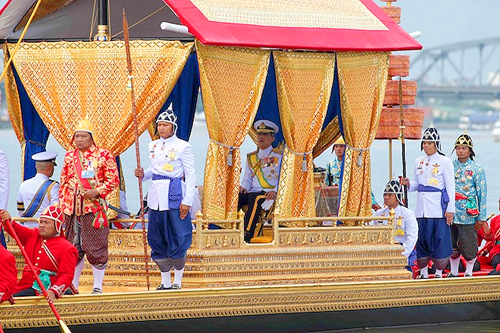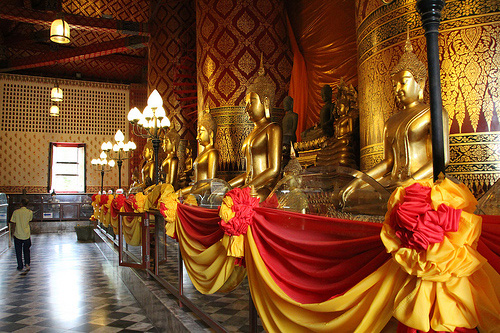A 13th c Thai capital, Sukhothai was the first independent kingdom.
The name translates to "Dawn of Happiness," indicating that the
Sukhothai period is considered a "golden age" in Thailand's history.
During this era, the alphabet was created under King Ramkhamhaeng,
setting the stage for artistic and intellectual developments.Today,
visitors can walk the ruins of this once great city, now a site
protected by UNESCO and restored thanks to an initiative of the Thai
King himself. Having historical significance and a variety of tourist
attractions, Sukhothai is easily accessible by plane, bus, and train
from Bangkok, Chiang Mai, Phitsanoluk, and Mae Sot.

Wat Mahathat:-The
most splendid wat of the present ruined city (and one of the oldest and
most important in Thailand) is the Wat Mahathat. It was near the
earlier Royal Palace (a wooden building of which no trace remains), and
this wat alone covered an area of 4 ha, surrounded by 185 chedis, six
wiharns of varying size, a bot, and eleven salas. The towering main
chedi at the center of the site is most impressive, with both a wiharn
and a bot. Built in a purely Sukhothai style, the top is crowned by the
tip of a lotus bud. The middle section resembles the Khmer prangs, and
the high square base is decorated by a procession of worshippers with 40
figures of about 1 m high on each side. The niches of the four corner
chapels show fine stucco work, rosettes, scenes from the life of Buddha,
and gods and demons in conflict. The central chedi once contained the
gilded statue of the Phra Buddha Shakyamuni, which King Rama I had
brought to the Wat Suthat in Bangkok at the end of the 18th c.
Wat Traphang Ngoen:-To
the west of Wat Mahathat, on an island covered with lotus blossoms in
the Traphang Ngoen ("Silver Lake"), lie the outstandingly beautiful
chedi of the Wat Traphang Ngoen and the proud columns from a larger
wiharn. Mountains form the backdrop of the chedi, which holds statues of
Buddha in its niches and is crowned by a lotus bud.
Wat Sra Si:-Wat
Sra Si makes a quintessentially Thai picture, as the bot stands on an
island in a pond surrounded by lotus flowers. The wat must have been a
magnificent sight when it stood in all its glory. Ten chedis still
stand, as do six rows of columns and the beautiful statue of a seated
Buddha. Some of the wat's buildings are still inhabited by monks. This
is where Loy Kratong (the light festival) is celebrated every November,
transforming the lake with thousands of tiny floating candles into a
fantastical sea of light.
Wat Sorasak:-The 24
exquisitely carved elephants that still guard the decaying chedi of Wat
Sorasak are the real draw and highlight of the park. Wat Sorasak was
constructed in 1412, toward the end of the Sukhothai Empire. The niches
are occupied by statues depicting Buddha sitting in a "western"
position, with legs hanging down. This elephant guard style is also seen
in other parts of Sukhothai, Si Satchanalai, and Kamphaeng Phet. Parts
of the wat have been restored in recent decades.
Wat Si Chum:-Visitors
to Wat Si Chum will be especially impressed by the mondhop: a huge,
windowless cuboid construction that stands on a high pedestal. Inside,
you'll find the colossal statue (nearly 15 m high) of a seated Buddha.
This impressive likeness is probably the Phra Achana mentioned in an
inscription by King Ramkhamhaeng in 1292, reinforcing the ancient
character of this wat and the surrounding ruined city.A bot in front of
the mondhop still has 13 limonite columns covered in stucco work. North
of the mondhop are the ruins of a small wiharn and a brick building that
contains a seated Buddha.
Wat Phra Pai Luang:-Extensive
Wat Phra Pai Luang is one of the oldest temples in the Sukhothai area.
Thought to date from the end of the 12th or beginning of the 13th
century, it was probably one of the most important in this region. Wat
Phra Pai Luang was presumably the main wat of the old town at the time
of the Khmer, before it was moved further south to its present position
in the ruined city. Beautiful stucco adorns the steps of the chedi. The
outside wall, foundations, and ruins of four rows of columns still
remain from the wiharn.

Though
less notorious than some of the temples in the old city, this is a nice
one to visit thanks to thinner crowds. And save it for later in the day
when you're winding your sightseeing down to enjoy the quiet sunset.
Wat Traphang Thong Lang:-You'll
find Wat Traphang Thong Lang, with its remarkable stucco relief, on the
road to Sukhothai. The flat relief on the southern side is the best of
its type in the Sukhothai style; it shows Buddha, striding over steps,
coming down from heaven Tavatimsa. Protected by two parasols, Buddha is
accompanied by the Hindu goddesses Indra and Brahma as well as by
worshippers. This is assumed to be the first visual representation of
the stepping Buddha from the Sukhothai period.Another flat relief on the
north side of the bot depicts, less artistically, Buddha taming the
elephant Nalagiri, which his cousin Devadatta had set upon him. The
relief on the west wall shows Buddha under a mango tree at the miracle
of Sravasti.
Wat Chetuphon:-Wat Chetuphon houses a
particularly beautiful example of classical Sukhothai-style - a
stepping Buddha in stucco (the only one of four to be have been well
preserved). The other three represent Buddha in sitting, standing, and
reclining positions. The chedi in the form of a mondhop contains the
Phra Si Arijya Metrai, the "Buddha of the future" statue. Wat Chetuphon
also has an unusual feature of slate walls sculpted like wood.
Wat Sapan Hin:-Wat
Sapan Hin lies on a hill at the edge of Yom plain and offers a fine
view of the mountains and Si Satchanalai. A paved path leads to the
monastery, giving it the name "temple of the stone bridge." This is
where King Ramkhamhaeng celebrated the Thot-Kathin festival each
October, marking the end of the Buddhist fasting period. There is an
impressive 12.5-m high statue of a standing Buddha in Sukhothai style,
leaning against a brick wall in the open. The right hand is raised in a
protective gesture, and it is deeply revered by the population of the
surrounding area. Nearby is a statue of a seated Buddha also in
Sukhothai style. Ruins of another temple and a chedi can also be found
in the area.
Wat Phra Bat Noi:-Wat Phra Bat Noi
("wat to Buddha's footprint") is also interesting with its unusual
chedi, which represents a mixture of Thai and Khmer styles. The central
part resting on a square basis has a niche on each side, occupied by a
smaller Buddha figure. The lower part of the apex has vertical ribbing
that, like the niches, is decorated with predominantly Hindu motifs. The
footprint from the wiharn is in the Ramkhamhaeng Museum.
Ramkhamhaeng Museum:-Opened
in 1964, the Ramkhamhaeng Museum contains numerous finds from
Sukhothai, Si Satchanalai, and Kamphaeng Phet - the three capitals of
the empire. The museum provides a good overview of the development of
the Sukhothai style from the era of Khmer influence to the rise in
popularity of the Ayutthaya style. Particularly noteworthy are a
stepping Buddha (the finest example of this type), a seated Buddha from
the Wat Chang Lom in Si Satchanalai (also on the ground floor), and a
seated bronze Buddha (upper floor). In the museum garden are other
statues and a ceramic kiln. The admission fee includes a detailed
brochure in English.
Si Satchanalai National Park:-If
you haven't had your fill of ruins once you've seen Sukhothai's Old
City, pay a visit to Si Satchanalai, second only to Sukhothai in
Thailand's early history. As in Sukhothai, there are remains of palaces,
temples, and houses. The top three temples to see are Wat Phra
Mahathat, Wat Chang Lom, and Wat Chedi Jet Taew. It's worth visiting in
order to get a fuller picture of this once-flourishing area and the
country's early kingdoms.
Celadon Kiln Site and Study Centre:-Here
you'll find a study in ancient craftsmanship and production. Five
hundred limestone kilns were found on this site, most of which are oval
shaped and span 7 to 8 m wide. A number of celadon pots and other goods
were also found still in excellent condition. Check out the excavated
pieces, and take in an exhibit of other ancient finds while learning
about the crafting process inside the center.
No comments:
Post a Comment